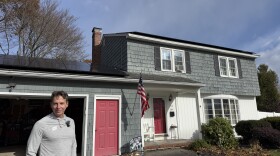Managers in the White Mountain National Forest are planning a series of controlled burns aimed at protecting homes in Conway from the growing risk of climate-drive wildfires.
The proposal aims to prevent fires in a developed area on the forest boundary, where the pine-driven ecosystem is prone to burning.
This risk could increase as New Hampshire gets hotter and drier in the summer due to climate change.
“We’ve always done prescribed fire every year – we have a regular burning program,” said James Innes, the district ranger in the project area, in an interview. “But I would say this could potentially be something we haven’t addressed at this scale before.”
This story is part of By Degrees, NHPR's climate change reporting project. Sign up for our email newsletter and take our survey to stay involved in future coverage.
Innes said he lives in one affected neighborhood, and has wanted to get out ahead of this kind of risk for several years as more small fires crop up in New Hampshire during dry spells.
“Every time I’m out here and it’s a dry, hot, windy day, I’m like, ‘Oh gosh, please, not today,’ you know?” Innes said. “Because all it would really take back there is someone to throw a cigarette down when it’s really dry. And you know how pine needles are – they just take off.”
At a public meeting on the project Monday night, Innes and other federal officials said the proposed resilience project could start this spring, as weather allows.
Prescribed burning would take place across roughly 210 acres in what's known as the wildland urban interface, west of Route 302 in Conway. Officials say they plan burns based on wind conditions to limit smoke exposure for neighbors in the adjacent Birch Hill, Moat and Dandiview areas.
Officials said the project is especially necessary where Conway abuts the national forest in order to avert potential property damage – already a possibility in New Hampshire, and one that could increase with hotter summers and more outdoor recreation in risky areas.

Forest Service fire manager John Neely said the government and public alike should be working to maintain their lands in a way that will reduce the impacts of wildfires.
“Fire doesn’t respect jurisdictional boundaries,” he said Monday. “It doesn’t care who owns the land – it’s going to move through the land regardless of who owns it.”
The burning will leave open patches that officials say should allow the forest to continue a cycle of healthy regrowth. They'll conduct similar work in the area as maintenance every 5 to 7 years.
The public can comment on the Conway project until April 2 and reach out to forest service officials for other ways to get involved. Similar projects could be in the works for parts of Albany and Bartlett in future.
Do you have questions or a story to share about forest fires in New Hampshire? We want to hear from you. Get in touch with the By Degrees team at climate@nhpr.org.








